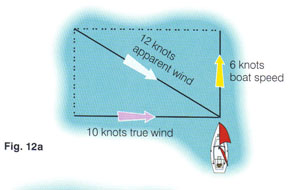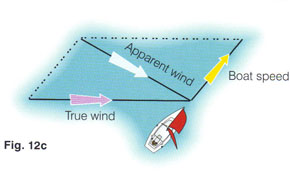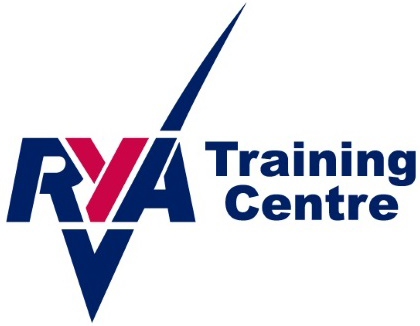Apparent wind / True wind
The issue of wind direction and strength becomes complicated as soon as a boat starts to move. Telltales and wind vanes on mastheads only indicate the true wind when a boat is stationary.
As soon as it starts to move they react to a combination of wind and the boat’s movement – apparent wind.

Fig 12a shows a vector diagram for a boat on a beam reach. The long side of the trapezoid represents 10 knots of true wind drawn to scale while the short side of the trapezoid shows the boat speed, 6 knots. The long diagonal represents the apparent wind. Note that the length of the line now shows 12 knots of wind speed and the angle of the wind crossing the boat has decreased to 60°. In order to maintain the same entry angle to the wind, the boat’s mainsail and jib had to be trimmed on -meaning, pulled in – progressively as the boat accelerated.

Fig 12b shows the apparent wind for the same conditions with the boat sailing close-hauled, at 45° to the true wind. You can see that the apparent wind builds significantly and the entry angle closes down as the boat accelerates forward to a full speed of 6 knots.

Fig 12c shows the same boat broad reaching at six knots in the same wind. This time the apparent wind decreases but the entry angle still closes down.
In all three of the illustrations the sails had to be considerably re-trimmed as the boat increased speed, and boat speed varies all of the time. Wind speed and direction are rarely constant, so it follows that, to keep a boat moving efficiently through the water, the sails need almost constant re-trimming to cope with the constantly changing conditions.
Remember, as soon as you start moving the windex or woolies will only show you the apparent wind. The same is true of the more basic electronic wind insruments. To display true wind information the wind instrument must interface with the log, or speed input.
The above is an extract from the RYA book “SAIL TRIM hanbook for Cruiers” which is avaialble from Sailtrain.
